The Society
Islands
August 18th to October 1st
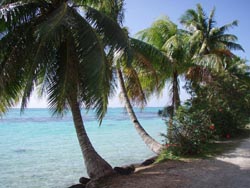 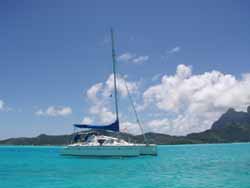 The Society
Islands are part of French
Polynesia in the south Pacific. The islands
were named by Captain James Cook after his 1769 voyage’s sponsor – Great
Britain’s Royal Society. The Society Islands are comprised of two
groups. The major islands in the Leeward group are
Raiatea, Huahine, Tahaa,
and Bora-Bora.
The Windward islands group includes
Tahiti
and Moorea.
These islands are spectacular for their natural and human beauty. The Society
Islands are part of French
Polynesia in the south Pacific. The islands
were named by Captain James Cook after his 1769 voyage’s sponsor – Great
Britain’s Royal Society. The Society Islands are comprised of two
groups. The major islands in the Leeward group are
Raiatea, Huahine, Tahaa,
and Bora-Bora.
The Windward islands group includes
Tahiti
and Moorea.
These islands are spectacular for their natural and human beauty.
The best thing
about the Society islands is the Polynesian people. Generally, the
people are good natured, friendly, giving and attractive. They are laid
back, rarely effected by the hustle and bustle that afflicts so much of
the world. Living is easy for the Polynesians. Time and money lacks
importance. The people seem energetic, honest, generous and gentle.
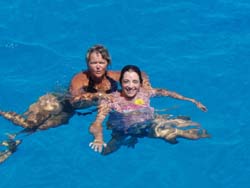 As an example of
the character of the people, on a bicycle trip around Huahine we stopped
at a local farm and asked if we could buy some coconuts and bananas. The
generous Polynesians would take no money and gave us a variety of
coconuts (there are 5 different types of coconuts). And they husked one
of the coconuts for us to try to make sure we liked them. As an example of
the character of the people, on a bicycle trip around Huahine we stopped
at a local farm and asked if we could buy some coconuts and bananas. The
generous Polynesians would take no money and gave us a variety of
coconuts (there are 5 different types of coconuts). And they husked one
of the coconuts for us to try to make sure we liked them. 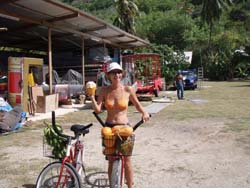 Similar
scenes repeated on different islands. More musings about the
Polynesian character
here. Similar
scenes repeated on different islands. More musings about the
Polynesian character
here.
Papeete is the
only city in the Society Islands and Papeete has some hustle and
bustle. It was the only island where hitch hiking was difficult. There
are some big city problems in Papeete, but there is an underlying
gentleness and spirit of fun. The side streets at night are full of
people playing games and socializing. And by an hour or two after
sunset the streets are deserted. Papeete is a city of about
125 thousand and the entire island of Tahiti is less than 2 hundred
thousand.
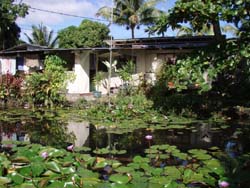 While violent
crime is rare, petty theft can occur especially in the few urban
areas. Our friends on the boat Bogtrotter had an outboard stolen and we
were the victims of an attempted theft in Papette. Click
here to
read a couple of amusing anecdotes about the thefts. While violent
crime is rare, petty theft can occur especially in the few urban
areas. Our friends on the boat Bogtrotter had an outboard stolen and we
were the victims of an attempted theft in Papette. Click
here to
read a couple of amusing anecdotes about the thefts.
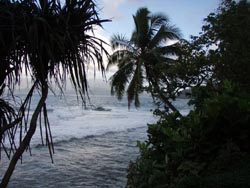 In the cool of the
late afternoon, the Polynesians play in their outrigger canoes. Gone
are the traditional wooden boats. Now most outrigger canoes are slim,
smooth, ultra light fiber glass canoes. These boats are incredible
light and it is surprising to see young men picking up a 20 foot canoe
and carry it down the street. There are also lots of bigger canoes,
which carry teams of 4-8 rowers. It is fun to watch them race around
the lagoons. In the cool of the
late afternoon, the Polynesians play in their outrigger canoes. Gone
are the traditional wooden boats. Now most outrigger canoes are slim,
smooth, ultra light fiber glass canoes. These boats are incredible
light and it is surprising to see young men picking up a 20 foot canoe
and carry it down the street. There are also lots of bigger canoes,
which carry teams of 4-8 rowers. It is fun to watch them race around
the lagoons.
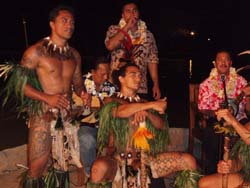 The energy of the
Polynesian character explodes in dance. Sexy, tribal and haunting, the
dancing dazzles. The pounding drums, the undulating hips, the gorgeous
women and men adorned with intricate tattoos costumes and flowers. The energy of the
Polynesian character explodes in dance. Sexy, tribal and haunting, the
dancing dazzles. The pounding drums, the undulating hips, the gorgeous
women and men adorned with intricate tattoos costumes and flowers.
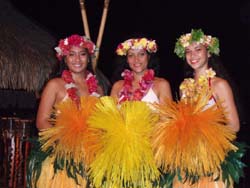 The
raw energy of the musicians and dancers is all part of the unique
Polynesian experience. The
raw energy of the musicians and dancers is all part of the unique
Polynesian experience.
The Polynesian and French peoples of the Society Islands handle visitors
and growth in a unique way. The distance of the islands from the more
populated parts of the world probably limits the number of visitors and
growth pressure. We were delighted that there were no multistory hotels
or buildings outside of Papeette.
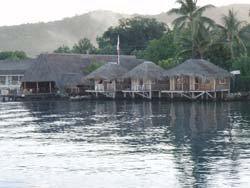 This must have
been no mean feat on islands like Bora Bora where the international
hotels must bring intense pressure and offer big dollars to build
upwards like the rest of the world. Bravo Polynesia for holding your
heritage and character!! This must have
been no mean feat on islands like Bora Bora where the international
hotels must bring intense pressure and offer big dollars to build
upwards like the rest of the world. Bravo Polynesia for holding your
heritage and character!!
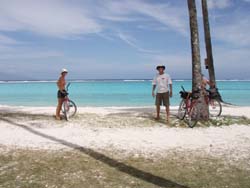 To go along with
the beautiful character of the people, is the natural beauty of the
islands. The islands are all volcanic with lush tropical growth and
fringing of barrier reefs. To go along with
the beautiful character of the people, is the natural beauty of the
islands. The islands are all volcanic with lush tropical growth and
fringing of barrier reefs.
Fringing reefs are
a build up of coral that surrounds the islands at a distance of a mile
or so. The fringing reef breaks the big ocean waves leaving beautiful,
shallow and protected lagoons inside the reef. These lagoon waters are
a natural habitant for all kinds of marine life. The lagoons are also a
perfect playground for people. God really did a really fine job in
designing these islands to be perfect places to nurture life. 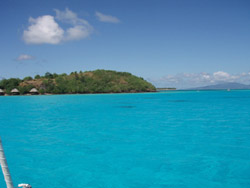
The gardens and
plantations that surround the mostly modest homes along the road sides
are delightful. Flowers, palm trees and lush growth everywhere. Were
delighted by the many gorgeous white sandy beaches where the turquoise
green waters lap at the shore. Where the blue green surf breaks
brilliant white on the fringing reef. Beautifully coloured coral heads
dot the green waters.
Expensive? Yes
indeed. Most goods and services are particularly dear after arriving
from Central or South America where things are very inexpensive. If you
plan to travel to French Polynesia buy as much as you can before you get
there. Bring lots of good rum for trading and you will do OK. Click
here for some examples of Polynesian pricing.
I
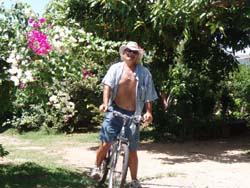 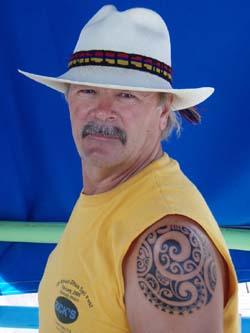 French Polynesia
was so much more than we had dreamed it would be. The Marqueses Islands
dazzled us with raw rugged beauty and their quaint adopted French
customs. Then the Tuamotu Atolls took our breath away and left us
gasping in awe as we swam with the sharks, snorkeled, dove, fished and
played in the warm clear blue lagoon waters. French Polynesia
was so much more than we had dreamed it would be. The Marqueses Islands
dazzled us with raw rugged beauty and their quaint adopted French
customs. Then the Tuamotu Atolls took our breath away and left us
gasping in awe as we swam with the sharks, snorkeled, dove, fished and
played in the warm clear blue lagoon waters.
The best of French
Polynesia was last. Leisurely trade wind sailing in the lovely Society
Islands. Tahiti, Moorea, Hua Hanie, Raiatia, Tahaa and most beautiful
of all - Bora Bora. Incredible inspiring oceanic tropical paradises.
Click
here for a
slide show of all the pictures shown on the Society Island section of
the page. If you want, more slide shows can be viewed by
clicking the links below: Well, the files are to big for the slow internet here. I will hook these links up later.
Tahiti
Moorea
Huahine
Raiatea and Tahaa
Bora Bora
It is now late September and the southern winter is waning. As the
Earth turns its southern face toward the sun, the heat intensifies.
The pleasant winter temperatures are giving way toward the sizzling hot.
We must vamoose before it gets really hot and the potential for tropical
storms increases. The storm season officially begins in December. 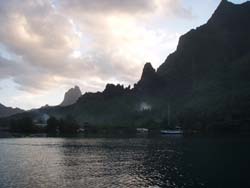
We set sail to the
southwest. The moon smiles a big yellow cheshire cat grin down on us as
Mustang Sally gallops over the waves toward the Cooks Islands. A
thousand southern constellations wink at us from above. The wind is
fresh from the north and the seas are still smooth. We relish the cool
breeze in the night air. We bid farewell to French Polynesia. We are
bound for Aitutaki, the most northerly of the southern Cook Islands.
|



